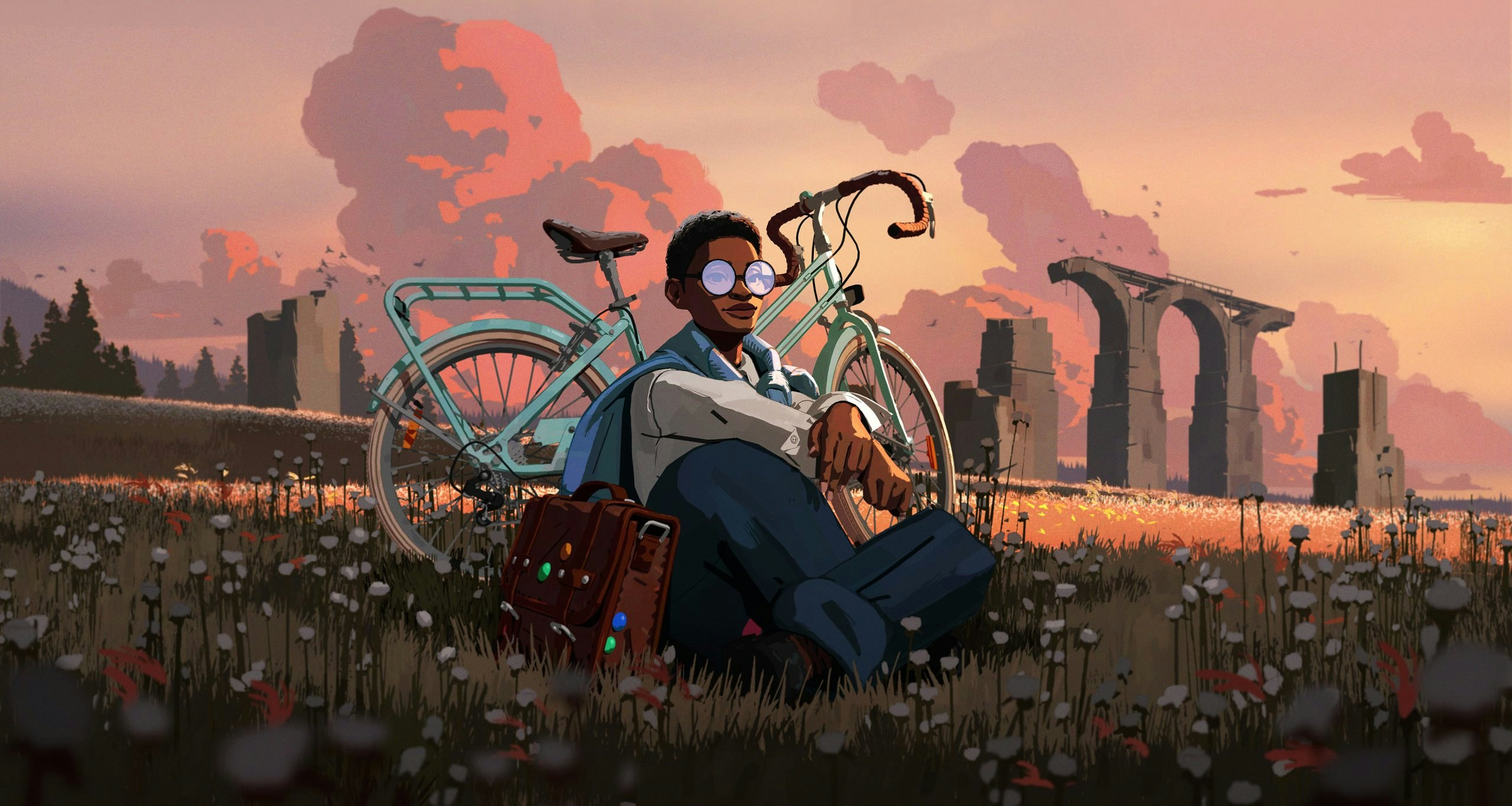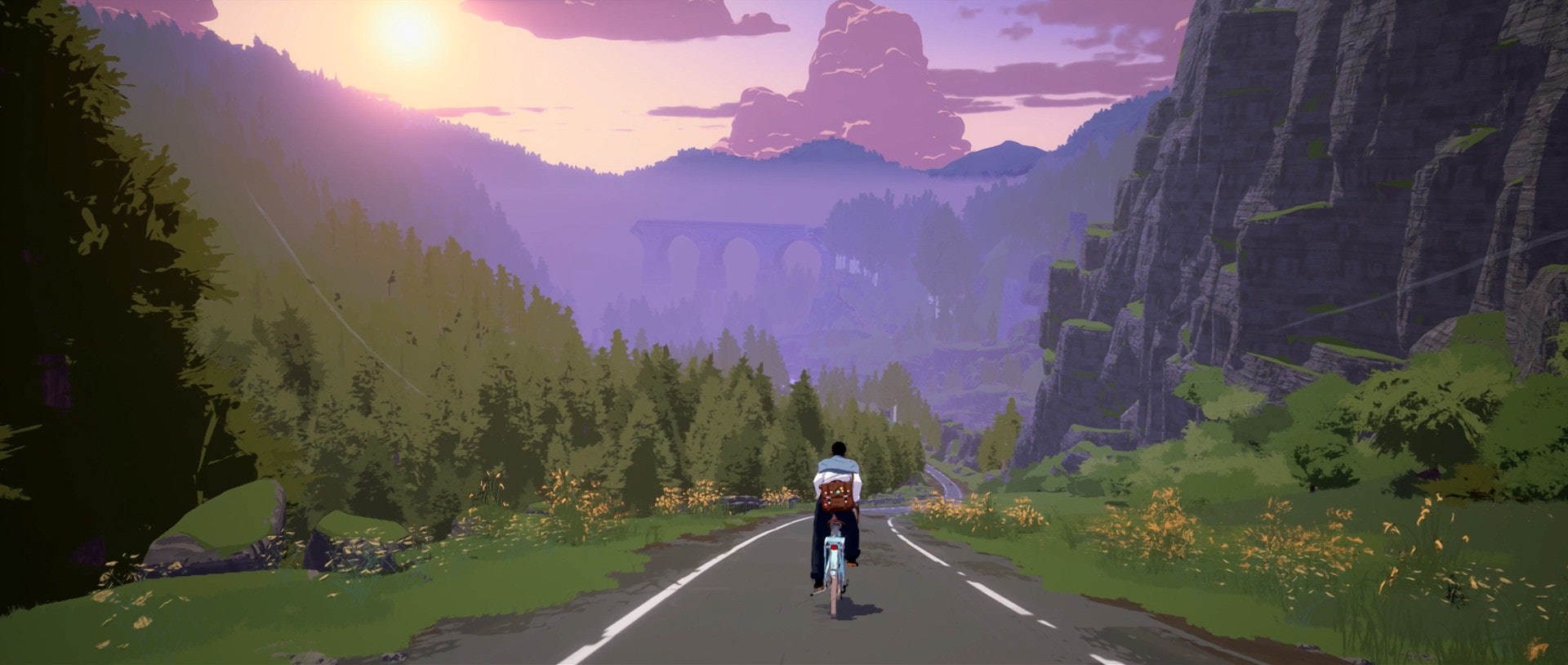
After a stretch of sustained pedaling, I crest the hill on my bike.
I tip over the edge, letting gravity take over and pull me down the long, winding road ahead. I fix my eyes on the sky, taking in its vivid purples and oranges in the feeling of peace before pulling over to snap a quick photo of the horizon and record the sounds of nature around me.
In moments like this, Season: A Letter to the Future shines. Developed by Scavengers Studio, Season is an extremely chill game about leaving home for the first time, touring the world on a bike, and recording the wonders you find along the way. Also, the world might be ending, but no one is letting that ruin their day. While it’s filled with scenes of beauty, Season’s awkward pace and muddled message leave it feeling a little undercooked.
Auspicious beginnings
Season opens just before you leave home to collect memories of the world as the season ends, an ominous event that’s more gestured at than explained. Your character Estelle and her mother are making a pendant to protect Estelle’s mind on the journey ahead. Doing so means Estelle’s mother has to give up five memories of her own — one for each sense. Estelle looks through her home and describes evocative memories and sensations tied to significant objects stashed throughout. Once you’ve made your choices, Estelle leaves with an emotional goodbye.
Outside, you’re introduced to Season’s simple camera and audio recorder and asked to capture your hometown before leaving forever. You can take all the time you want to compose shots and arrange them in a journal. It’s peaceful, and Estelle chimes in with observations about the subjects you’re recording, building the world slowly and subtly.
I couldn’t believe my luck. It’s only the first month of 2023, and Season already seemed like the kind of game I’d be convincing people to play for the rest of the year. The courtyard where you’re asked to gather your first recordings is staged perfectly. Decorations from a party last night still hang in a tree, and signs of the village’s lived-in past are everywhere. After a leisurely stroll to capture all I could of the gorgeous little village, I was eager to see what else the world had to offer.
For the first few hours, I was captivated. Estelle’s journey takes her to a run-down shipping depot and a rainy field dotted with windmills, all filled with compelling material for your journal. She muses on how much there is to learn from the world and what it’s like to feel true loneliness for the first time so far from home.
It feels like the start of something beautiful, but like the fading season itself, its splendor doesn’t last.

Fenced in
When Estelle comes to Tieng Valley, she meets a stranger for the first time. He works for a mysterious, supposedly altruistic group called the Grey Hands. He gives her a map, something Season hasn’t had up until now, which shows the massive expanse of Tieng Valley. It’s not clear at this point, but this is where you’ll spend almost the entirety of Season — and it’s where its edges start to fray.
Tieng Valley is breathtaking. Whether you’re riding on its paved streets or rugged trails, it’s full of sights and sounds worth preserving from whatever impending doom the end of the season brings. You enter the valley on its final day, with most residents already evacuated to a shiny apartment complex on a hill. Only a few stragglers remain before the Grey Hands destroy an ancient dam to flood the village, rather than wait for it to crumble on its own.
The sense of freedom Season imparts in its first few hours makes it truly unique. But despite Tieng Valley’s size, it feels confining. You can’t move on until you talk to the last few residents and learn their histories. Season stops being about seeing the world at this point. It becomes a story about Tieng Valley, about what the Grey Hands are really up to, and about what it means for a season to end.
Season’s fascinating intro hints at a globe-trotting tour where Estelle will learn about the world for the first time, and see how other people live and what shaped them. But once she reaches Tieng Valley, the game gets lost in unraveling the mystery of one event that’s consuming one community. That’s not necessarily a problem on its own, but neither the mystery nor the few remaining citizens of Tieng Valley are all that compelling.

Stuck in the past
Tieng Valley is weighed down by memory, and it brings Season down with it. The people of the valley are traumatized by memories of past conflicts, and much of life there is centered around how to live with that trauma or forget it completely.
Season fixates on this same struggle, but unlike the people of Tieng Valley, it never picks a side. It settles into the most anodyne musings on memory and how people live with the past. It’s good to live in the moment, but some things are worth preserving for the future. You have to leave the past behind, but parts of it should be held onto. The themes Season tackles are so broad, it’s hard to pick a message out of all the noise. And when events in Tieng Valley seem to be building to some encompassing conclusion, the game instead comes to an abrupt, unfulfilling end.
Recording the world as it heads for a massive change is a joy on its own. Photography in Season is extremely limited, with just a handful of filters as your major means of expression. On top of limited camera controls, environments rein you in more than they seem at first, meaning you can’t explore or climb the terrain to compose a perfect shot — one of the things that makes real-life photography so fun.
Despite its limitations, I was happy to linger in Season’s first few environments, recording what I found and decorating my scrapbook with remnants of the journey. At a few points in the game, your journal will unlock a new page not dedicated to a location, but to a question. The closest thing Season has to quests, these pages ask you to capture certain objects in photos or audio recordings, but you have a good deal of freedom over how you approach them. That’s all the structure Season needed. Tying the majority of the game to understanding Tieng Valley’s history and the Grey Hands’ plans sets Estelle on a path too narrow for the vast potential of the world.
There’s a lot to like in the unhurried exploration of Season: A Letter to the Future, but in the end, I respect it more than I enjoy it. Its focus on small human stories and creative expression is admirable, even as they’re drowned out by a lukewarm plot, and the world’s beauty can’t be overstated. But rather than the meditative, meandering journey its opening suggests, Season gets locked into a single story that centers on the cataclysmic fate approaching its world more than the wonder that already fills it.
6/10
Season: A Letter to the Future launches on January 31 for PS4, PS5, and PC. Inverse played the PS5 version for the purposes of this review.
INVERSE VIDEO GAME REVIEW ETHOS: Every Inverse video game review answers two questions: Is this game worth your time? Are you getting what you pay for? We have no tolerance for endless fetch quests, clunky mechanics, or bugs that dilute the experience. We care deeply about a game’s design, world-building, character arcs, and storytelling come together. Inverse will never punch down, but we aren’t afraid to punch up. We love magic and science-fiction in equal measure, and as much as we love experiencing rich stories and worlds through games, we won’t ignore the real-world context in which those games are made.







